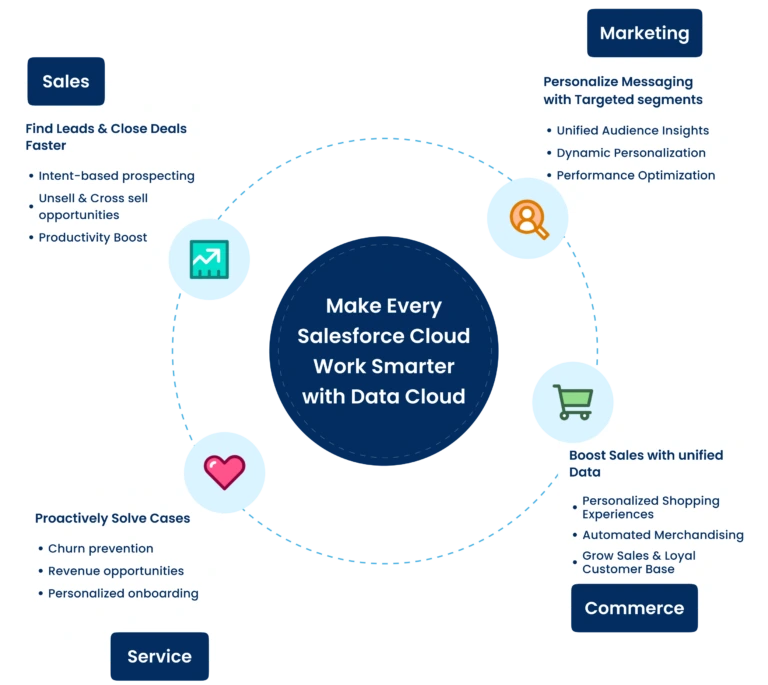
- Introduction to Data Skew
- Importance of Data Skew Management
- Types of Data Skew (Ownership, Lookup, etc.)
- Impact of Data Skew on Performance
- Identifying Data Skew Issues
- Managing Ownership Skew
- Managing Lookup Skew
- Preventing Data Skew Problems
- Using Indexing to Reduce Skew
- Optimizing Query Performance with Skew
- Best Practices for Avoiding Data Skew
- Troubleshooting Data Skew Issues
- Conclusion
Introduction to Data Skew
Data skew in Salesforce occurs when records are unevenly distributed across certain users, fields, or objects, often leading to system inefficiencies. This typically happens when a large number of records are linked to a single owner or lookup field, causing imbalances that can slow down performance, increase query response times, and trigger locking issues. Such skew is especially common in larger organizations where some users or records are heavily concentrated in specific objects. For instance, when one user owns thousands of records, it creates ownership skew, which can cause delays and performance bottlenecks. Properly understanding and addressing data skew is crucial for maintaining system reliability. Investing in Salesforce Training can help teams recognize and mitigate skew-related risks early, leading to more efficient data handling and smoother operations across the platform.
Importance of Data Skew Management
Managing data skew effectively is essential for maintaining high performance and stability in Salesforce environments. Without proper handling, data skew can disrupt operations, impact user experience, and lead to avoidable system inefficiencies.
Key impacts and considerations of data skew in Salesforce:- Performance degradation: Data skew can significantly slow down system operations, affecting overall performance.
- Record locking issues: During bulk operations, skewed data increases the risk of record locking, as Salesforce prevents simultaneous changes to the same parent record.
- Processing delays: These locks lead to slower transaction processing and higher chances of hitting governor limits.
- Slow query performance: The system takes longer to retrieve and filter large volumes of unevenly distributed data, reducing query efficiency.
- Negative user experience: Users may experience slow loading times, lagging dashboards, and reduced responsiveness.
- Governor limit risks: Poorly managed skew increases the likelihood of breaching Salesforce governor limits.
- Reduced productivity: Teams lose valuable time due to system lags and delays caused by skewed data relationships.
Become a Salesforce expert by enrolling in this Salesforce Training Online Course today.
Types of Data Skew (Ownership, Lookup, etc.)
There are three primary types of data skew in Salesforce: ownership skew, lookup skew, and account data skew. Ownership skew occurs when a large number of records are assigned to a single owner, such as a specific user or queue. This creates performance bottlenecks during record updates and causes excessive locking. Lookup skew happens when many records reference the same lookup value. For example, if thousands of contacts reference the same account, it creates lookup skew, slowing down operations involving those records. Account data skew arises when many child records (e.g., opportunities, contacts) are linked to a single account, creating a large data cluster that can cause record locking issues during bulk updates. Each type of skew affects system performance differently, making it essential to apply specific strategies to mitigate their impact. Tools like Salesforce SOQL can help analyze and detect skew patterns through efficient queries.
Impact of Data Skew on Performance
Data skew significantly impacts Salesforce performance in several ways. First, it leads to record locking contention. When multiple users or processes attempt to update skewed records simultaneously, Salesforce locks them to prevent data conflicts, causing delays and increased processing time. Second, skewed data causes slow queries. Queries involving skewed records take longer to execute due to inefficient indexing and retrieval, affecting report generation and dashboard loading times. Third, data skew increases the likelihood of batch job failures. Large data volumes associated with skewed objects can cause batch jobs to time out or fail, affecting data processing tasks. Finally, skewed data increases the risk of governor limit breaches, as operations consume more resources, leading to runtime errors. Organizations must address data skew promptly to prevent performance degradation and ensure smooth operations.

Identifying Data Skew Issues
To effectively manage data skew, it’s crucial to identify the areas where it occurs. Several methods can assist in this process. The Salesforce Optimizer tool provides insights into data distribution and highlights objects and users with large data volumes. Running SOQL queries can help pinpoint ownership and look up skew issues. Reports and dashboards displaying record ownership or lookup relationships can also identify potential skew by filtering for large record counts. Furthermore, event monitoring logs in Salesforce can reveal slow-performing queries caused by data skew. By proactively identifying skew, organizations can take preventive measures before performance issues arise. To deepen your understanding, consider investing in Salesforce Training to better recognize and manage data skew challenges.
Example:Running a SOQL query like:
- SELECT OwnerId
- COUNT(Id)
- FROM Account
- GROUP
- BY OwnerId
- HAVING COUNT
- (Id) > 10000
This reveals ownership skew patterns.
- Reports and dashboards filtering for large record counts can highlight skew.
Managing Ownership Skew
Effective management of ownership skew in Salesforce is essential to maintaining system performance and avoiding operational bottlenecks. When too many records are owned by a single user or queue, it can lead to performance issues such as record locking and delayed processing.
Key strategies for managing ownership skew:- Distribute record ownership: Avoid assigning too many records to one user or queue; spread ownership across multiple users or queues to balance the load.
- Use public groups: Assign records to public groups instead of a single owner to allow for broader access and reduce the risk of skew.
- Apply sharing rules: Implement sharing rules to provide access to multiple users, supporting more even distribution of ownership.
- Break data into smaller batches: When importing large volumes of data, divide it into smaller segments and assign them to different owners to avoid skew.
- Reduce contention and locking: These practices help minimize record locking, enhance system responsiveness, and ensure stable performance.

Managing Lookup Skew
Lookup skew occurs when many child records reference the same parent record, creating a data bottleneck. To manage lookup skew, organizations should use lookup filters to limit the number of child records referencing a single parent. Denormalizing data by creating additional lookup fields or splitting relationships into smaller objects helps reduce lookup skew. Avoiding the use of popular or default lookup values prevents clustering, improving performance. Archiving or deleting old records further reduces the impact of lookup skew. By distributing lookup references more evenly, organizations can prevent performance degradation caused by lookup skew. In cases where background processing is needed, consider using the Future Method in Salesforce to handle operations asynchronously without locking records.
Are you getting ready for your Salesforce interview? Check out our blog on Salesforce Interview Questions and Answers!
Preventing Data Skew Problems
Preventing data skew in Salesforce requires a forward-thinking and proactive strategy. By distributing data wisely and maintaining system hygiene, organizations can ensure smooth performance and avoid potential bottlenecks.
Key Strategies to Prevent Data Skew:- Balance Data Distribution: Assign records evenly across multiple owners and lookup values during data creation and imports.
- Use External Storage Solutions: Offload large volumes of data to external platforms like Amazon S3 or Google BigQuery to reduce the load on Salesforce.
- Implement Data Archiving Policies: Regularly archive rarely accessed records to keep active data volumes under control.
- Monitor Data Growth Patterns: Use reports and dashboards to track data growth and identify early signs of skew.
- Maintain Consistent Performance: Proactively managing data prevents slowdowns and supports stable system performance.
Using Indexing to Reduce Skew
Indexing plays a crucial role in improving query performance and mitigating the impact of data skew. Salesforce uses both standard and custom indexes to optimize data retrieval. Adding custom indexes to frequently queried fields ensures faster search performance, even in skewed data scenarios. Using composite indexes, which combine multiple fields, enhances search efficiency by reducing query execution time. Optimizing SOQL queries by using indexed fields in WHERE clauses prevents full table scans, speeding up data retrieval. Additionally, avoiding NULL conditions in SOQL queries ensures that the system uses indexes effectively. Proper indexing reduces the performance impact of data skew and improves query efficiency. For managing workload distribution alongside data performance, Omni-Channel Salesforce can help route work items effectively based on agent capacity and skill.
Optimizing Query Performance with Skew
Optimizing query performance plays a vital role in minimizing the impact of data skew. By writing efficient queries and using the right processing techniques, organizations can handle large datasets without degrading system performance.
Key Strategies to Optimize Query Performance:- Use Selective SOQL Queries: Filter records using indexed fields to reduce dataset size and enhance query speed.
- Apply Low Cardinality Filters: Use filters that return fewer unique values to keep queries efficient.
- Limit Returned Records: Use the LIMIT keyword to reduce the number of records returned, lowering query load.
- Use Asynchronous Processing: For large data operations, leverage batch Apex or queueable Apex to avoid performance bottlenecks.
- Efficiently Retrieve Skewed Data: Well-optimized queries allow access to skewed data without sacrificing system performance.
Best Practices for Avoiding Data Skew
To avoid data skew, organizations should follow industry best practices. Balancing record ownership distribution ensures no single user or queue owns a disproportionate number of records. Using multiple lookup fields spreads child references across different parents, reducing lookup skew. Regular data maintenance, including archiving and deleting old records, prevents large data clusters from forming. Data partitioning, which involves splitting large objects into smaller, more manageable objects, reduces the performance impact of skew. Using Salesforce Optimizer regularly allows organizations to detect potential skew issues and address them proactively. For a better understanding of the platform’s capabilities, explore Salesforce vs. Salesforce Platform to choose the right approach for your organization’s needs. Following these best practices ensures that data skew is minimized, maintaining system stability and performance.
Thinking About Earning a Master’s Degree in Salesforce? Enroll For Salesforce Masters Program by Microsoft Today!
Troubleshooting Data Skew Issues
When troubleshooting data skew issues, organizations should start by reviewing Salesforce Optimizer reports to identify objects with large data volumes. Monitoring system logs helps detect slow-performing queries caused by skewed data. Adjusting sharing rules reduces the number of record access checks, improving performance. Refactoring the data model by creating new relationships or breaking large objects into smaller entities reduces the impact of skew. For severe performance issues, engaging Salesforce support provides access to advanced troubleshooting tools and recommendations. By proactively troubleshooting data skew, organizations can resolve performance issues quickly and maintain a stable Salesforce environment.
Conclusion
Data skew in Salesforce is a significant performance challenge that can impact system stability and user experience. It occurs when records are unevenly associated with a single parent record, like one user owning too many accounts. Identifying skew early and applying strategies such as role hierarchy adjustments, balanced data ownership, and indexed queries helps prevent performance issues. By leveraging best practices and proactive monitoring, organizations can maintain efficient operations and scalability. Teams can also benefit from Salesforce Training to build the skills needed to manage and optimize data structures effectively, ensuring long-term success with the platform.




